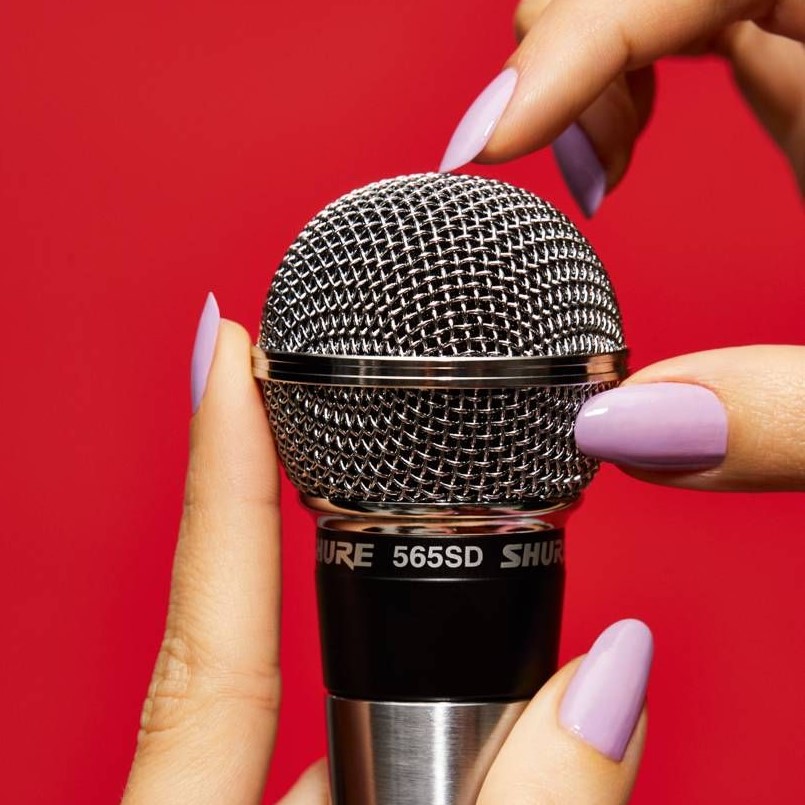Intimate Encounters Within the Ear: Microphone-touching and the Gender Politics of ASMR
Tap-tap-tap… is this thing on?
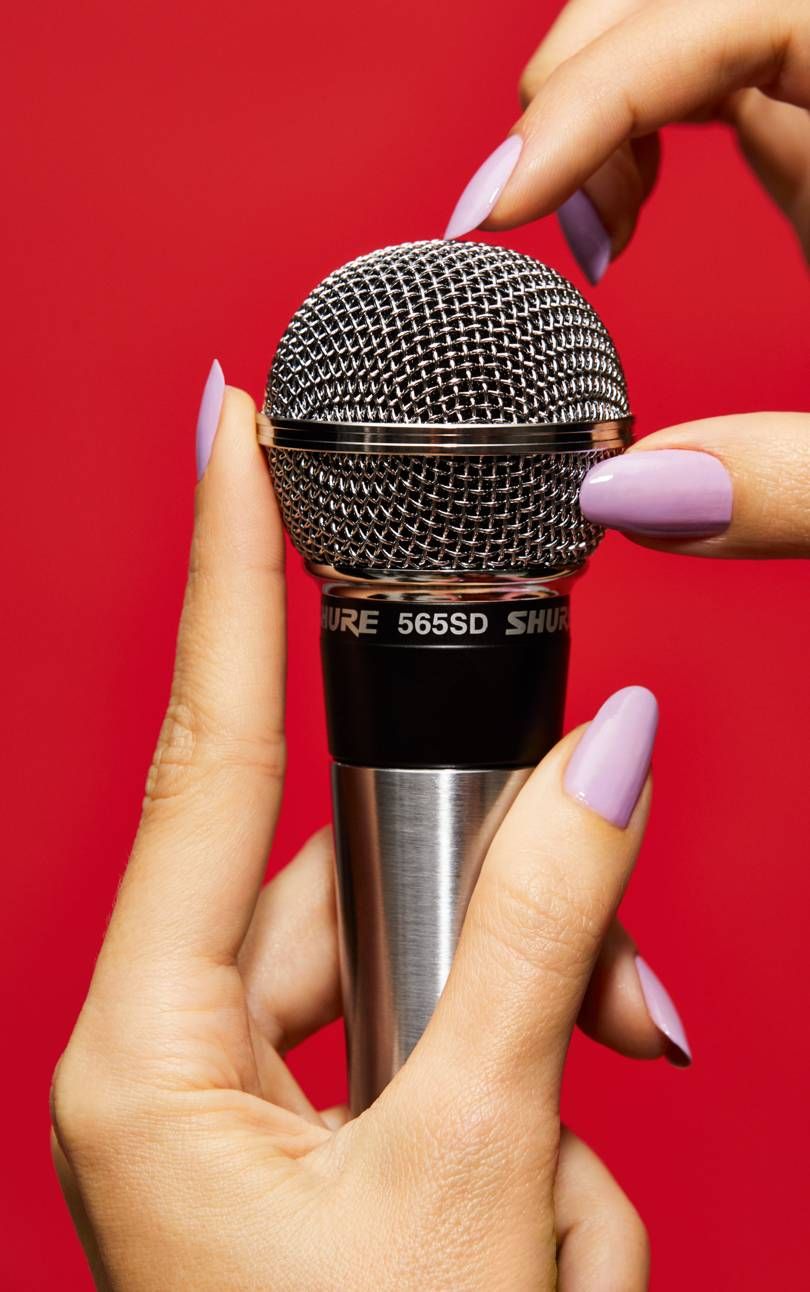
Figure 1: Manicured female hands touching industry standard dynamic microphone by Shure. Credit: JUCO
Though most people don’t realise it, the sound that touching a microphone produces has a highly particular function as an ASMR trigger. While those who experience strong ASMR are thought to be a minority of around 20% (according to an estimate by ASMR researcher Richard Craig1), the compulsion to handle microphones and amplify the sound of touch is a commonly observable phenomenon that can be seen in churches, at political meetings, and wherever children are given access to vocal amplification. Microphone‑touching is a taboo in the world of professional audio engineering, but over the past ten years ASMR artists – a self-directed workforce of young, femme sound designers – have been building an online subculture that turns this compulsion into a regular and systematic feature of design. Brushing, tapping, scratching, kissing, and even licking the microphone are features of popular ASMR content and the ubiquitous voiceless whisper track is a marker of how touch (of air) on the microphone, rather than traditional resonant sonic content, is becoming an instrument of affect in ASMR culture.
ASMR makers are rediscovering the microphone firstly as a toy through a performance of ludic play and secondly – as an item of anthropological curiosity through an open-ended exploration of how an object in the hand becomes a technology. The sound design of ASMR is innovating away from a historicised model of audio-visual culture in which the sonic is produced as a separate process from the visual and layered on top of image in a post-production process. The performance of the ASMR artist imposes a regression on the sonic culture in order to reunite the aural and the visual through knowing the world as it is experienced through a sense of touch via the world of sound. As such, ASMR functions as a sub-category of Foley – the embodied art of cinematic sound effects – and takes the technique beyond concrete sound into a connected virtual environment with a sonic character that is distinct from the physical landscape. This development does not have a connection with the dramatic conventions of naturalism or realism but should not be dismissed as ‘’goofy”, poetic, or sentimental2, nor trivialised as weird, faddish, or a passing trend. Preeminent theorist of the post-dramatic Hans-Thies Lehmann wrote, “ever since the Impressionists offered banal meadows instead of grand subjects and Van Gogh featured simple chairs, it has been evident that the trivial, the reduction to the greatest simplicity, can be an essential prerequisite of the intensification of new modes of perception.”3 Names are presently being given to feelings that have been present for a long time but unacknowledged in language and culture. The ASMR tingle response has become an intimate sensory commodity that is growing in value and influence – the 2019 ASMR-designed Super Bowl ad for Michelob beer used not only the distinctive quiet and intense sound palette of ASMR with its tapping, fizzing, and whispering, but also placed microphones at the centre of the frame.4 This privileging of sonic process, overt reference to the scenography of a digital subculture, and distinguishing of a newly codified characteristic of sound has been made possible by grassroots ASMR video creators who have avoided the historic disjuncture between sound design and listening.
DIY ASMR makers manifest what sound art theorist Salomé Voegelin calls the “intersubjective self”5 in which there is the potential to move between the position of subject and object of listening. Voegelin posits a gender politics of sound that she terms “feminine sonic materialism”6 and this is an apt description of what ASMR videos can be read as manifesting. Dynamic, gendered knowledge of the overlap between touch and sound in subjective experience may account for the strange power that ASMR has to conjure tingling corporeal sensations7 that speak to pre-conscious, non-verbal patterns of relaxation and pleasure. ASMR video content ranges from the therapeutic to the quasi-pornographic and touching the microphone features across these types of content. The interpellation and the figuring of these gendered types of labour challenge received notions of what sound is, how it works, and the considerable gaps that exist in the wider sound culture. Here I will suggest a cultural lineage of offline feminine labour for ASMR mic-touching videos and describe how ASMR practice reaches beyond the physical or acoustic reach of the sound designing body. It goes much further, using the microphone to simulate the ear and the materiality of sound to rouse the meridians of listening bodies around the world.
![Figure 2: Screenshot from ASMR video: [ASMR] Ear Cleaning / No Talking 耳かきの音 / SR3D by hatomugi ASMR, 2019, Source: https://www.youtube.com/watch?v=Tcja_H6KOrI&list=PLAdXhR1o2X6SmCC3DzCAK2LPgD50F1K0D, access 18.10.2019.](http://en.glissando.pl/wp-content/uploads/2020/07/3zO9kegk.png)
Figure 2: Screenshot from ASMR video: [ASMR] Ear Cleaning / No Talking 耳かきの音 / SR3D by hatomugi ASMR, 2019, Source: https://www.youtube.com/watch?v=Tcja_H6KOrI&list=PLAdXhR1o2X6SmCC3DzCAK2LPgD50F1K0D, access 18.10.2019.
It is not easy to analyse ASMR videos from the perspective of sound design, because these are not cultural artefacts that confine themselves to a single modality. An ASMR video does not proceed by what social anthropologist Edmund Leach calls “bounded chunks” in order to make the videos themselves or the perception of them easily analysable. I recommend clicking on the links and following the timestamp in the screenshots to have the best insight into my remarks about this experiential turn in the field of sound design. *headphones on*
Figure 2 shows an ear-shaped pair of binaural microphones. The model contrasts with microphones shaped as batons or sticks, such as those featured in Figure 1, by sculpturally figuring the human hearing apparatus. Commercial availability of microphones styled as ears is a development over the past decade that has occurred contiguously with the emergence of ASMR culture. Ear-shaped mics are favoured by many ASMR makers and the microphones’ design shares a highly specific concern of ASMR culture in considering sound in relation to the space directly next to and even within the ear. What is at stake is not a territory of physical space that happens to be proximate to the ear, but a subjective space that grants intimate access to the hearing apparatus of an individual headphone-wearer. The physical proximity that these sounds evoke is at an intimate scale that can induce discomfort; many people in the comments sections below ASMR videos express shame around enjoying ASMR. This shame might be partly because of omissions in the received traditions of sonic culture. For example, the user manual for the industry standard Shure SM58 – a microphone similar to the one in Figure 2 – describes features including “brightened midrange and bass roll off to control proximity effect”8 and a built-in pop-filter which “reduces undesirable wind and breathe noise.” The reference to “undesirable wind and breathe (sic) noise” describes a mainstream audio-cultural aesthetic sensibility that has been organised to exclude classic ASMR triggers, such as the volatile play of the elements and sounds that evoke the interior of the body like breath, tongue clicks and other mouth sounds. This distortion within the sound culture to occlude sounds that bring the experience of physical closeness has started to shift in the age of the internet as an appetite for these sounds has been revealed. In contrast to this, the listed features of ear-shaped 3Dio FS binaural microphone include “spatial relevance and acoustic immersion” for “hobbyists looking to record in full 360° professional audio”.9 This notion of “relevance” refers to a replication of acoustic space but also refers to the sounds of the body itself, a connection to the hobbyist who is capturing sound. The audio profession’s concept of “microphone placement” seems calculated to keep a distance between performer and microphone. 3Dio have cannily understood that the design of their microphone lends itself to emergent sound design practice in a virtual space populated by amateur enthusiasts. It is ironic that in the online space, where the physical body is absent, such an intimate investigation of the aural has emerged. It is perhaps less surprising that this prolonged examination of the ear has challenged the status quo by providing cultural artefacts that eschew categories of sonic industrial object, such as “soundscape”, “soundbite”, “film” and “song.”
The ASMR video featured in Figure 2 is from a Japanese ear-cleaning video that is meant to recreate a ritual grooming procedure not be familiar to a western audience. In spite of this lack of context, it is objectively effective as an ASMR video and as such is promoted up the YouTube algorithm to an international audience. This is interesting for a number of reasons; firstly, it is clear that this traditional nurturing practice, usually offered from a mother to a child, may be a source of offline ASMR (in other words, ASMR has always existed but it is only becoming codified in the age of the internet); secondly, it is evident that offline cultural practice that is female-coded is being replicated online (suggesting that feminine culture has insight into sensory practice that is only just being recognized). Thirdly, it suggests that ASMR has a universal quality, crossing cultural and linguistic barriers. Donna Haraway wrote, “A cyborg is a cybernetic organism, a creature of social reality as well as a creature of fiction.”10 The hands that are manipulating these binaural ear-shaped microphones play both the role of a mother and the role of a Foley artist, an interesting vision of a sound design that combines technologies of gender with technologies of sound. The fluffy drumsticks add a performance art flourish to a spectacle that somehow unites the bizarreness of fiction with the drudgery of social reality. This cyborg knowledge of the potential for sonic technology to form a continuum with the anatomy forms a potential constitutive part in the cyborg revolution predicted by Donna Haraway who wrote of “transitions from the comfortable old hierarchical dominations to the scary new networks of Informatics of Domination”.11 The entry of feminine actors in the field of sound may have implications not just for the standard feminist demand for entry into the labour market but also for an articulation of the potentially manipulative, ineluctably relaxing role of sound in the cybernetic age for a more comprehensive wrapping of the tools for political control.
It is in no way self-evident that the sound of touching a microphone is similar to the sound of physically having your ear touched, yet apparently this is precisely the premise on which the featured ASMR ear-cleaning video operates. It partly functions through mimesis – a special “ear pick” or “mimikaki” is used to scrape at the ear-shaped microphone as it would a human ear – and partly through a staging of Foley sound design in which a stick with fluffy tips produces a more textured and tickly sound than a cotton bud or wet wipe would. If you rub and tap one then both ear cavities with your fingers you will hear the ruffling, distorted cotton wool tones of microphone-touching. Ear-cleaning IRL produces next to no acoustic sound at all. The “sound” of ear-cleaning IRL is experienced through the structure of the ear itself as it is touched. As such, it is not perceived as sound but rather as a touch-presence. The evidence here that the touch-presence of another human being can be replicated remotely through microphone-touching creates an ontology of sound that exceeds the mimetic and becomes an intimate encounter that is staged within the ear, that is inherently affective and predicated on trust. As Claudia Strauss stated “The realm of cognition is inseparable from the realm of affect; thus cultural models should be understood as learned, internalised patterns of thought-feeling.’’12 Thus the ASMR audient comes away with ears that are no cleaner than before they watched the video but with an experience of a range of results that mimic an offline cultural model of nurture. ASMR artists have forged a relationship with sonic technology and virtual transmission to transmit full-body experiences; this relationship involves sounds that can’t be heard without microphones and feelings that have recourse to “learned, internalized patterns” relating to cultural models of gender.
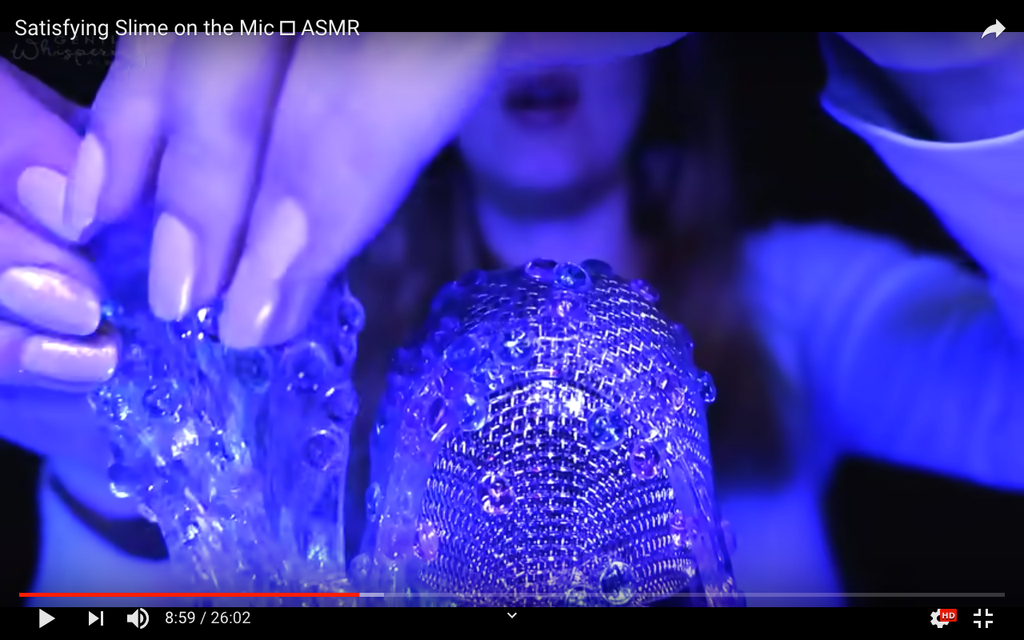
Figure 3: Screenshot from Satisfying Slime on the Mic, ASMR video by Gentle Whispering ASMR, source: https://www.youtube.com/watch?v=gnb06fkBidA, access 17.10.2019
The Figure 3 screenshot from a Gentle Whispering video is of a woman’s hands with perfect manicure intact – a female-coded scenographic hallmark of ASMR. It shows her pulling a sheet of slime over the wire net cover of a studio microphone in a gesture that performatively unites sound and sight, because the sound literally has the same source as the visual. The slow, suspenseful rhythm of Gentle Whispering ASMR’s performance is sensuous and the strangeness of the scene with its beautifully manicured hands and blue lights heightens the quasi-erotic effect. The slime on the microphone evokes the interior of the body in a world of sound that is more horror movie than whale song; gently it wrenches you from an experience of acoustic sound to an interior space of bodily experience. This is not the traditional, therapeutic world of relaxation but somehow is edgier, more thrillingly weird. The quality of that strangeness is worth pausing over, because it marks a moment of sensually crossing a threshold by searching for sensory experience beyond the limits of the body and beyond the remit of physical space. In the moment of experiencing ASMR via an online video, the meridians of the body can be said to themselves be reaching into virtual space.
ASMR videos overturn ideas about microphones being part of a sonic apparatus that stands aloof from the body in the form of gear, kit, or equipment. In one of the first book-length surveys on theatre sound, Ross Brown refers to the reputation of theatre sound specialists as “noise boys” and he bemoans the “obsession” with kit that prevents these experts from being seen as artists rather than technicians.13 This is a marked difference from the ASMR artist who collapses the space between themselves as a performer and the microphone as a piece of kit in a manner which makes a mockery of the notion of “microphone placement”. Rather, she places her performing body in a cyborg relation to technology and collapses the perception of space between a performer and a headphone-wearing audient. This is possible through the radical synch of image and sound down fibreoptic cables of internet broadband to describe onset of contact between performer and microphone in a way that increases skin conductivity and results in a sensation of touch. Mixing hardware and wetware through innovating new ways of touching microphones is yielding new sonic textures and techniques of audio composition.
The phenomenal success and penetration of ASMR as a genre lays down a challenge to the limited amount of existing criticism on how audio-visual perception works. Film sound theorist Michel Chion neologised the term “synchresis”, combining “synchrony” and “synthesis” to describe “the spontaneous and irresistible mental fusion, completely free of any logic, that happens between a sound and a visual when these occur at exactly the same time”.14 The connotations of the mastery within this description of a historic form of disinformation relate to an exteriorised synching of sound to image. This seems retrograde and magician-like when you consider that the uncanny quality of a freely variable combination of aural and visual elements might have very little to do with a God-like ability to deceive or manipulate by divorcing origin and destination of sound and simply be a phenomenon of performative synch. We have the microphones required to capture all sound on set but are prevented from using them by a narrow realist dramatic tradition. Without any intervention between sound and image in ASMR, the sounds are elevated from the way that we experience them in acoustic space partly on the level of volume which may be freely adjusted and partly through delivering a fantastic level of textural detail. The radical monitoring of concrete sound in a technologized setting in ASMR evokes familiar textures and objects while transforming their use as tools for a conscious rather than a passive listening experience.
The perfect synch of the sound and image within ASMR is no less uncanny than the power of Foley to bring film footage to life. Like Foley, it is an embodied process that knows the world of sound as it is known through the sense of touch. In this sense, ASMR culture is a sort of revenge of the Foley artist who steps out of the wings and places their work in front of the camera. As we see in Figure 3, ASMR artists have done away with realism and put the microphone in the centre of the frame in a ludic exploration of technology. The “satisfying” quality of the slime on the mic might just be the same “irresistible mental fusion” described by Chion, in which sound and image are synchronized in what feels like authentic unity. In the case of film sound, it is a designed unity across a team of workers, while in ASMR this unity is written into the form of a live performance and fed through the sensory profile of the sound artist-director who is guided by an expert knowledge of how to self-stimulate the ASMR response.
Some ASMR makers cross the physical/digital threshold by integrating ASMR into an imaginative roleplaying scenario in which the touch relationship between audient and performer requires a playful suspension of disbelief. The popular “cranial nerve exam” ASMR scenario uses a to-camera technique that performatively pitches the rectangular field of a screen as consistent with human anatomy by placing the microphones to the left and right of the camera as if those are the ears of the audient, while the performer, framed in closeup, carries out a bodily examination. Olivia Kissper’s famous ASMR voice – the reason her name is a portmanteau of “kiss” and “whisper” – is her main sound design tool. By filling out the soundtrack with her whisper, she aurally supports the efficacy of her visual triggers, which in this case are accompanied by a limited use of concrete sound. She touches your cheeks with a cotton bud to test sensation, she offers a pipette to the nose to test your sense of smell, she touches your face to feel if it is symmetrical. Constance Classen has written about a historical tendency to gender the senses, “In accordance with the association of man with mind and woman with body, men tended to be linked with the «rational» senses of sight and hearing, and women with the «corporeal» senses of smell, taste and touch.”15 Olivia Kissper eschews concrete sound and microphone touching, but I have included her work here, because it demonstrates how ASMR is parasitic to sound rather than inherently aural. Kissper touches the camera and uses visual triggers, reaching out in front of the lens so her fingertips blur out of focus with proximity in order to evoke a feeling that she is reaching towards your eye. This use of touch on the camera offers a correlative to touch on the microphone and is evidence of Classen’s theory of sensory hierarchy that feminine audio-visual practice is in fact focused on a broader base of sensory modalities rather than a love of sound and image for their own sake.
ASMR invokes a definition of listening that comes from the theatre world – “dynamic embodied attending in the world” – rather than an activity that switches off the eyes, skin, nose and mouth while being concerned exclusively with the sonic.16 The design of this video illustrates how ASMR is not reliant on a single modality and functions in direct physical contact with the camera as well as the microphone. This interaction with technology is revealing how an Aristotelian compartmentalisation of the senses is out of time in the age of the experiential turn. The result is a broken fourth wall, a style of post-Brechtian performance drawing excessive attention to the technologies that give them form. The intellectual puzzle the alienation presents, the incongruity of the appeal to touch in the virtual medium, and the free dialectic arrangement of elements such as “cranial nerve exam + novice nurse cosplay” and “hypnosis + DNA test” combine to create an intoxicating postmodern array of stimuli. The dialectical aspect of ASMR is another massive topic, as the medium develops simultaneously along DIY and corporate lines. The advertising industry’s content sits alongside that of the bedroom hobbyist all under the same four-letter hashtag, while porn ASMR sits alongside ASMR made by and for children and so on and so on.
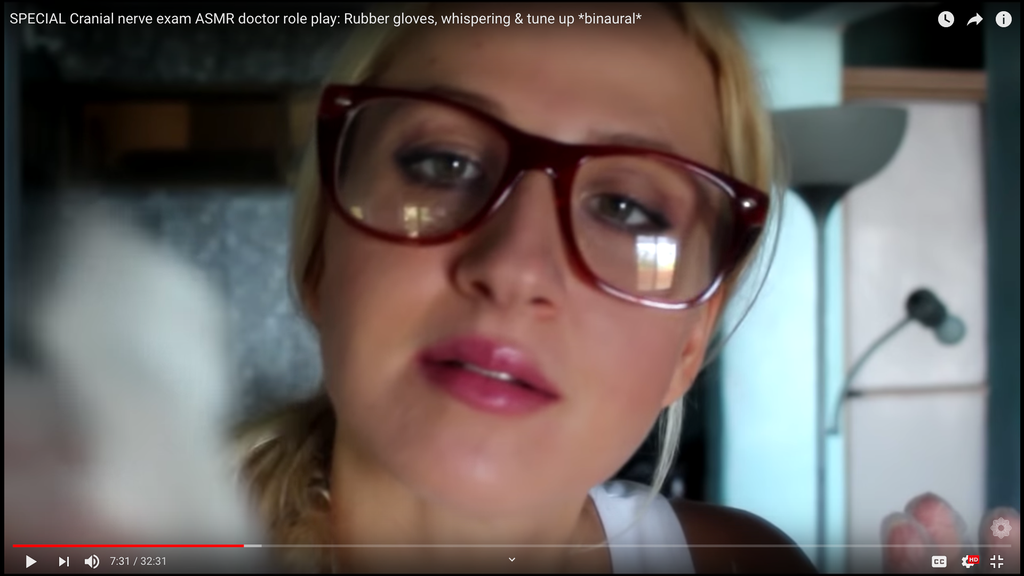
Figure 4: Screenshot from video SPECIAL Cranial nerve exam ASMR doctor role play: Rubber gloves, whispering & tune up *binaural* by Olivia Kissper ASMR, source: https://www.youtube.com/watch?v=yU_lVwbV5_U&t=660s, access 12.11.2019

Figure 5: Screenshot from video Cranial Nerve Exam ASMR with DNA Testing and Hypnosis | Roleplay by Olivia Kissper ASMR, source: https://www.youtube.com/watch?v=zbZ0X60Irvc, access 12.11.2019

Figure 6: Screenshot from video NOVICE NURSE Does ASMR Cranial Nerve Exam | Medical Role Play by Olivia Kissper ASMR, source: https://www.youtube.com/watch?v=pQl-5LAGArk, access 12.11.2019
As you see, ASMR videos are growing in ambition and are even starting to abord the cinematic. As the genre matures, we see more involved scenarios, cutaways, edited sequences, scripts, and other trappings familiar from industrial film. It continues however to exploit material relating to the body and the ear in surprising ways. Latte ASMR’s “Relaxing Piercing Café” maintains a lot of the dramaturgy that we saw in Olivia Kissper’s oeuvre, and develops the sense of place and occasion while maintaining much of the female-coded labour. The piece serves an unspoken requirement for intimate listening but develops into a sort of detailed love letter to the ear itself. Interestingly, there is no assumption about the gender of her client, though the focus on earrings and prettiness code feminine characteristics into the receiving end of the roleplay. On the delivery side, she elaborately makes coffee and then sits to conduct a consultation about an ear piercing. She lists the parts of the ears while she touches the microphones as if she is touching those parts of your ears. There is no interest in character and it is a masterclass in emotional labour rather than a dramatic structure. It also bears similarity to techniques from hypnosis for drawing attention into different parts of the body to move towards a transcendence of the corporeal. Here, the virtual stands in for access to other realms of consciousness and the author’s caring presence creates a “publicly observable facial and bodily display”17 to serve up a contentment product of pleasantly strange escapism.
In Figure 6, the ASMR artist introduces vocabulary for body parts we have, but may have never identified, as if speaking magic words; tragus, helix, outer conch, inner conch. Once more, in Figure 7 we see models of ears, but this time each of the named parts are adorned with a piercing. As the video goes on, the idea of piercing as being relaxing ceases to be paradoxical and we experience the interaction as an uncanny celebration that invites a feeling of reverence; she repeatedly compliments your looks and handles the equipment and the microphone that she touches in lieu of the actual ear with infinite care. She whispers and leaves spaces as if she is receiving a response. The piercing is preceded by the application of a “numbing spray” which allays fear and justifies an unexpected sensation. The moment of the piercing itself resists a mimetic interpretation through managing the process as a physical stimulation of the microphone that suggestively transmits to the ear of the audient. The reception of sound through headphones has a substantial effect on how sound, as a material, affects the body. Sound designing an ear piercing is a peculiarly perfect moment for describing formally how sound touches and then pierces through the body. In terms of the character of this extraordinary moment in the performance ecology, Hans-Thies Lehmann’s writes about the postdramatic as a way of “framing” performance that is an “irruption of the real”.18 Latte ASMR’s reframing of the ear as site signals ASMR as a postdramatic audio form of disquieting power; through performing sounds that invoke affective calm a forcible entry can be made. Latte ASMR touches the microphone in a manner that effectively manages this stressful moment of transforation. Receiving sound as a touch-presence in the ear is a process that makes us vulnerable, but it is a drama on the scale of sensory perception that usually goes unarticulated in performance models that prefer social models of interaction. This informs why ASMR as a form of sonic stimulation is suitable for people who have differences in ability around social interaction such as those on the autism spectrum.19 This application of ASMR culture has potential for an inclusive, sensory model of cinema that achieves what Virtual Reality has so far done with extremely limited success, which is – to promise touch and then actually deliver on that promise.
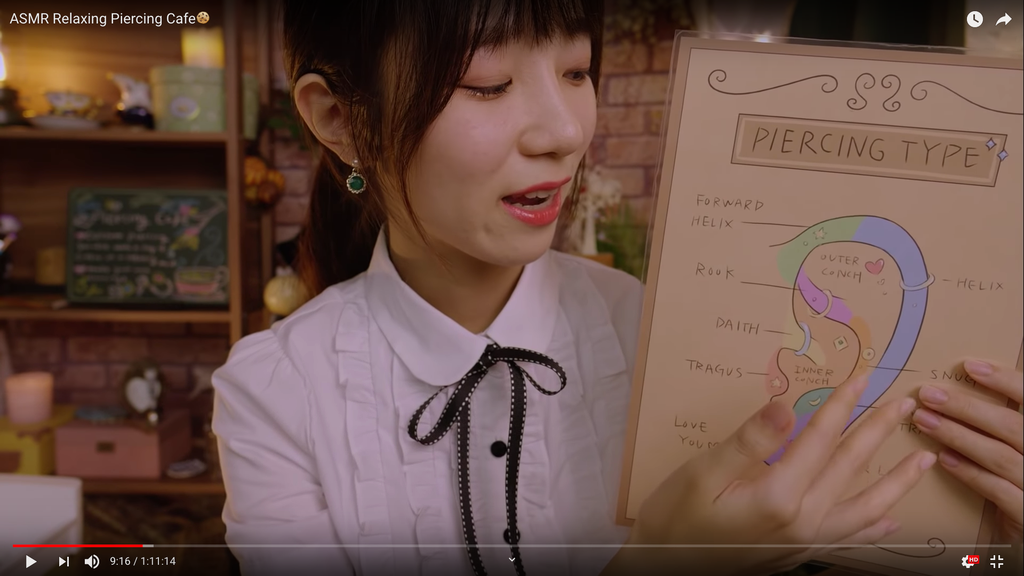
Figure 7: Screenshot from video ASMR Relaxing Piercing Cafe? by Latte ASMR, source: https://www.youtube.com/watch?v=o7m6d_GEzVA&t=403s, access 12.11.2019

Figure 8: Screenshot from video ASMR Relaxing Piercing Cafe? by Latte ASMR, source: https://www.youtube.com/watch?v=o7m6d_GEzVA&t=403s, access 12.11.2019
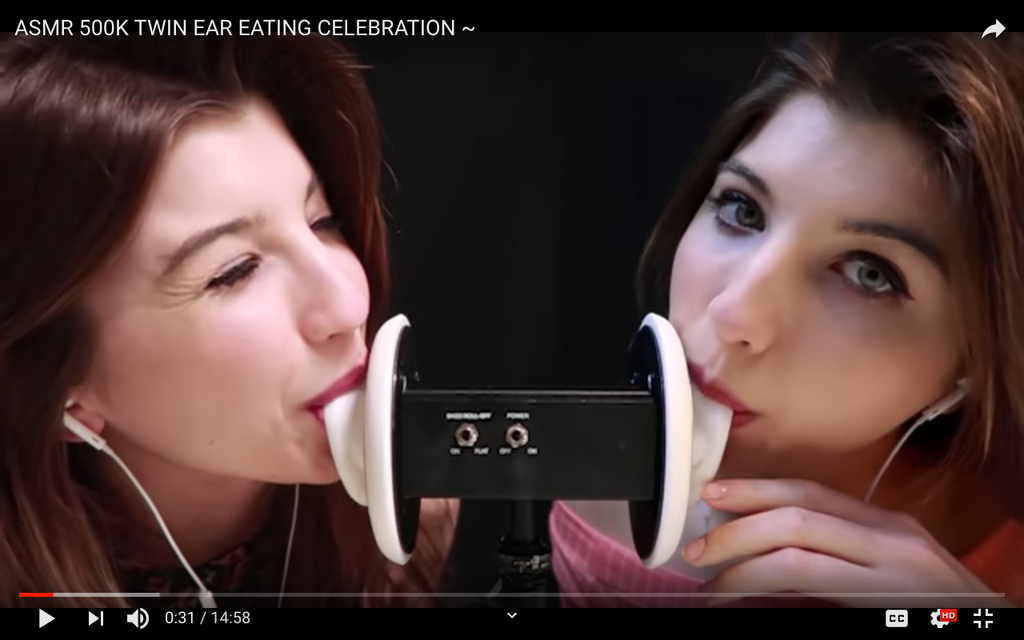
Figure 9: Screenshot of Frivolous Fox ASMR video ASMR 500K TWIN EAR EATING CELEBRATION, source: https://www.youtube.com/watch?v=k2U7MdhioYw&t=72s, access 11.11.2018
The question of how headphones have affected the development of ASMR culture can also be considered from the point of view of the ASMR maker, as they use headphones to route their performance through their own sensory profile. In Figure 9 we see Frivolous Fox wearing the standard white headphones that we see people wearing on the bus as they listen to content on their phones. She is interacting with a 3Dio binaural microphone, experiencing her own content as she produces it and responding in real time to its effectiveness to guide her performance as she explores the gestural world of microphone licking in an open-ended fashion. The technologized and pornified ingress of the touch of the microphone is placed within the body of the headphone user as they peruse online content. That online content is at present only quantified in terms of clicks, subs, comments, likes, advertiser dollars, and rank in the algorithm. However, these are only the secondary results of cyber activity. In terms of the character of internet content, this routing of sensory data through the wetware of the gendered human body constitutes a sensorial reprogramming through an unsolicited type of surplus labour.
The success of an ASMR artist depends to a considerable degree on expertise based in the ability to self-stimulate the phenomenon. A smartphone in selfie mode operated via touchscreen is like an ASMR readymade; when you start and stop the capture it is as if you are reaching out to touch yourself in a classic finger pointing visual trigger. The selfie mode of cameras doubles the process of the artist looking at their own image and appearing to make eye contact with their audience. As per the screenshot in Figure 9, Frivolous Fox does not maintain constant eye contact but moves between a listening pose and looking to camera to develop a humorous complicity with her audience. This variety in her attention comments on the performance and her own response to it without the need for words – there is an implicit assumption in a parity in the quality of the experience. Therefore, the use of technology to constantly monitor the self within ASMR is not just about self-stimulating sensual pleasure but has potential to extend what feminist film academic Laura Mulvey called “to-be-looked-at-ness” to the aural. Frivolous Fox is listening to the process of being listened to and effortlessly folding this feedback loop into an ongoing improvisation. Many ASMR artists, Frivolous Fox included, can be seen within a paradigm of what postfeminist digital cultures theorist Amy Shields Dobson calls “digital dreamgirls and heterosexy love.”20 This makes it hard to distinguish between content that is straightforwardly, visually narcissistic and immersive content that, Alice-like, goes through the mirror to perform a uniquely subjective reality.
The sharing of ASMR videos on an internet platform has identical means of production and dissemination as pornography with an essential exception: the type of microphones used and the manner of interaction with this technology. In 2019 China censored videos featuring “mouth sounds” because it classified them as pornographic, in spite of being sound rather than image-led and featuring no sex or nudity. ASMR video maker Frivolous Fox has designed pornographic characteristics into her online handle with its reference to her “frivolous” nature and her “foxiness”, but also into the video content itself (see Figure 9). The title “Twin ear-eating” clearly references a pornographic trope of fantasy sexual congress with identical twins. The video is framed as a “celebration”, as a thank you to fans for bringing her channel subscriptions up to half a million, a tacit acknowledgement that this content is a gift that many of them have been requesting off the back of previous videos. Another of her videos entitled “Extreme Mouth Sounds for Tingle Immunity” has over 18 million views. The title tells us that people are overdosing on this content to the extent that they can no longer feel tingles, a clear parallel with internet-era sexual impotence. In a single ASMR video you experience as much ASMR as you might find offline in a whole year and, drug-like, there is a limit to how much a person can physically take, before they go numb and feel no response. However, the length of ASMR videos described in this article is representative in that they are typically several times the length of the average video on free site Pornhub. Therefore, while Frivolous Fox’s appearance may seem “heterosexy” at a glance, her manner and duration of interaction with the microphone perhaps resembles queer female sensuality more readily than mainstream models of heteronormative phallus-centred sexuality.
Aural stimulation is certainly sensual, but is not straightforwardly sexual; the Sheffield University study by Dr. Poerio proved that heart rate does not increase when ASMR content is perused, which is consistent with the theory that ASMR is not a classic sexual response. Indeed, Frivolous Fox has posted disclaimers protesting this point. This did not prevent YouTube from demonetising her content and demoting her videos in the algorithm for compromising “community guidelines” when users reported it for being inappropriate for a general audience. In the meantime, the number of mic-eating videos are proliferating as new actors replicate successful ASMR videos which have millions of views and experienced makers are discouraged from making new content by the censorship imposed on their old ones. This not only clips the wings of a branch of sound design which has strong female representation but denies sound-led visions of sensory stimulation that have potential to explore sensory pleasure in a broader sense than the sexual.
Having perused the ASMR ear-cleaning video that I discussed at the beginning of this article, I decided to seek out an IRL ear-cleaning salon on a trip to Japan to attempt to compare the experience of ASMR video with its real-life correlative. This article concludes with a description of this experiential research. In October 2019, I was invited to share a performance at a conference organised by Creative Research into Sound Art Practice and University of the Arts, Tokyo, called Sound::Gender::Feminism::Activism. I took advantage of the trip to visit the East Shinjuku branch of the Yamamoto Mimikaki ear-cleaning salon. Here is what happened:
The business was marked at street level in a backlit sign with a floor by floor directory of companies occupying the building; a restaurant, a parcel business, a nail salon. I went up three storeys in a lift and there was a door with a picture of a man lying on his side with his head on the knee of a woman in a kimono who was touching his ear; so I knew I definitely had the right place (Figure 10). A man stood at a small desk at the entrance to a corridor of curtained cubicles. The atmosphere was hushed and a bit stuffy.
He accompanied me up a flight of stairs and I was asked to wait a moment in the hallway while he went in ahead of me. He emerged, invited me in and I met a diminutive Japanese woman, younger than myself, dressed in a kimono, white socks, and Japanese sandals. She spoke to me in a hushed voice, in English, inviting me to remove my shoes and enter the cubicle on the left, which I did. The cubicle had a little futon mattress, a lamp, a station resembling a bit a makeup table, with some paraphernalia and a wicker screen dividing this space from an adjacent similar one . She offered me tea – hot or cold – and she left me alone for a few moments while she prepared this, during which I took a few pictures. After I drank my hot tea, she knelt at the head of the bed and invited me to lie down on my side. I felt awkward but I took up the traditional ear-cleaning position with my head at pillow height on her knee. She took a soft piece of cloth, folded it in half, placed it over my eyes and tucked it neatly under the helix at the top of my ear. This created a subtle difference in temperature – warmth below the cloth where it touched my head and cooler above it where the ear stood proud in the air. Her first direct touch of the outer conch of the ear was with a loosely twisted wet-wipe – cool, soft, wet and crinkly. There was the sound of crinkling as she opened a packet and then she gave me an ear massage. Starting at the lobe, a pinching pressure was gently and gradually exerted, moving up and round to the upper rim of the helix. The circular oppositional rubbing between her thumb and forefinger was extremely relaxing. Then, she gently folded my ear forward to press it toward the entrance to the ear several times, using different points at the top of the ear to initiate the movement. This is an unintuitive movement for the ear but it seemed to release pressure located where my ears meet my head and felt good. After that, a large cotton bud with some lotion, soft and cool, followed the path of the ear’s curve from above the lobe to the rim, doubling round and down towards the inner conch of my ear. Next, she flipped a light on and I felt it shine on my face and presumably down my ear. Something sharp, gently applied – the ear-cleaning tool which is something like a scalpel with a tiny finial spade. This was scraped back and forth in a little scratching motion along the same path as the cotton bud. She moved it past rook, snug, tragus, and daith toward the inside of the ear. The scratching was gently excruciating, like having an itch soothed, and the presence of the tool between the inside and the outside of my body was intimate and urgent, taking all of my attention. At moments when my body tensed up she responded by slackening off, speaking to me reassuringly in a whisper and then persisting. The procedure was repeated on the other side then she asked me to lie on my back and gave me a firm head massage: face and scalp. Then I sat up for my shoulder massage which began as a shoulder rub and developed into a drumming, whacking, double-handed pummel. When she stopped, my whole body hummed with vibration. I thanked her, gently gathered my things and headed back down to the street and took in what I had heard and what I had felt. To my surprise I felt fabulous, like I had been asleep and experienced a huge cloud of oxytocin – the love hormone.
The achievement of ASMR in translating touch into the virtual space is potentially of immense interest not only because it pushes sound design out of the aural and into the experiential, but because it operates as a technology of gender, disseminating styles of interaction that are culturally defined as feminine, intimate, and private, and devolving these characteristics away from the physical, biological realm. As such, they have potential as feminist performance scores that instruct in the use of sound as a form of nurture that can be made visible, accessed in an inclusive fashion, and potentially culturally reproduced offline.
Statistic from Richard Craig quoted in: Amelia Tait, The Dodgy, Vulnerable Fame of YouTube’s Child ASMR Stars, “Wired Magazine”, 2019, https://www.wired.co.uk/article/child-asmr-video-stars-on-youtube, access here and later 9.02.2020. ↩
Salomé Voegelin, The Political Possibility of Sound, Bloomsbury, New York 2018, p. 162. ↩
Hans-Thies Lehmann, Postdramatic Theatre, Routledge, London/New York 2006, p. 101. ↩
ASMR beer commercial commissioned for Superbowl 2019, Ad Mater 2019: Michelob ULTRA Pure Gold, https://www.youtube.com/watch?v=JbdhDlljM18, access 23.11.2019. ↩
S. Voegelin, Listening to Noise and Silence: Towards a Philosophy of Sound Art, Continuum, New York/London 2010, p. 14. ↩
S. Voegelin, The Political Possibility…, op. cit., p. 131. ↩
The relaxing effects of ASMR were verified in a recent scientific trial: “ASMR was associated with reduced heart rate and increased skin conductance levels. [my italics] Findings indicate that ASMR is a reliable and physiologically-rooted experience that may have therapeutic benefits for mental and physical health.” Giulia Lara Poerio, Emma Blakey, Tomas J. Hostler, et al., More than a feeling: Autonomous sensory meridian response (ASMR) is characterized by reliable changes in affect and physiology, “PLoS ONE”, vol. 13, no. 6, 2018, https://doi.org/10.1371/journal.pone.0196645, access 22.10.2019. ↩
Page 1, Shure SM58 Vocal Microphone user manual, available for download at: https://pubs.shure.com/guide/SM58/en-US.pdf, access 8.11.2019. ↩
3Dio ‘Description’ webpage: https://3diosound.com/pages/user-guide-manual-3dio-binaural-microphone, access 8.11.2019. ↩
Donna J. Haraway, Manifestly Haraway, University of Michigan Press, Minneapolis 2016, p. 5. ↩
Ibid., p. 28. ↩
Claudia Strauss quoted in Tim Ingold, The Perception of the Environment, Routledge, London 200 p. 161. ↩
Ross Brown, Sound: A Reader in Theatre Practice, Macmillan Education UK, Basingstoke, p. 3. ↩
Michel Chion, Audio-Vision, Columbia University Press, New York 1994, p. 6. ↩
Constance Classen, The Color of Angels: Cosmology, Gender, and the Aesthetic Imagination, Routledge, New York 1998, p. 66. ↩
P. Sven Arvidson quoted in George Home-Cook, Theatre and Aural Attention: Stretching Ourselves, Palgrave MacMillan, Basingstoke 2015, p. 11. ↩
Arlie Hochshild, The Managed Heart: Commercialization of Human Feeling, University of California Press, Berkeley 2003, p. 7. ↩
H.-Th. Lehmann, op.cit., p. 99. ↩
The potential for ASMR as a helpful tool for those on the autism spectrum has been confirmed in the American research: “Using ASMR as audiovisual therapy can serve as a notable component to early intervention, alleviating symptoms associated with meltdowns and struggles of emotional self-regulation…ASMR may be the next step in promoting self-care in assisting individuals diagnosed with ASD”. Ariana Galente, Nafees Alam, Autonomous Sensory Meridian Response as an Intervention to Autism Spectrum Disorder, “Psychology and Behavioral Science International Journal”, vol. 13, no. 2, 2019, https://juniperpublishers.com/pbsij/pdf/PBSIJ.MS.ID.555859.pdf, access 23.11.2019. ↩
See: Amy Shields Dobson, Postfeminist Digital Cultures: Femininity, Social Media, and Self-Representation, Palgrave Macmillan, New York 2015. ↩


